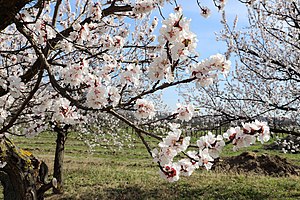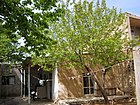Note: This is a project under development. The articles on this wiki are just being initiated and broadly incomplete. You can Help creating new pages.
Difference between revisions of "Prunus armeniaca"
| (One intermediate revision by the same user not shown) | |||
| Line 1: | Line 1: | ||
| − | + | [[File:Aprikosenblüten bzw. Marillenblüten (Oberloiben).JPG|thumb|right|''Prunus armeniaca'']] | |
| + | '''Prunus armeniaca''' is a deciduous tree with sturdy, tortuous branches forming a rounded canopy. It can grow 5 - 10 metres tall. The apricot has a long history of cultivation, dating back in China to around 2,000 BCE. It is often cultivated as a fruit crop in many areas of the temperate and subtropical zones - the fruits mainly being dried or processed due to the difficulty of bringing them fresh to the market in good condition. The tree also produces edible seeds and oil has a range of medicinal applications and yields a good quality wood. | ||
==Uses== | ==Uses== | ||
| − | {{Uses|}}, {{Uses|}}, {{Uses|}}, {{Uses|}}, {{Uses|}}, {{Uses| | + | {{Uses|Indigestion}}, {{Uses|Skin constions}}, {{Uses|Asthma}}, {{Uses|Coughs}}, {{Uses|Chronic bronchitis}}, {{Uses|Constipation}}.<ref name="Uses"/> |
==Parts Used== | ==Parts Used== | ||
| − | {{Parts Used|}}, {{Parts Used| | + | {{Parts Used|Fruits}}, {{Parts Used|Seeds}}. |
==Chemical Composition== | ==Chemical Composition== | ||
| − | <ref name="chemical composition"/> | + | Apricot contains vitamin C, beta-carotene, thiamine, iron, fiber, potassium, niacin, fruit acids, and a variety of sugars. Hamawy apricot seed kernels (sweet), Amar apricot seed kernels (bitter) and treated Amar apricot kernels (bitterness removed) have been evaluated biochemically. <ref name="chemical composition"/> |
==Common names== | ==Common names== | ||
| Line 16: | Line 17: | ||
===Dravya=== | ===Dravya=== | ||
===Rasa=== | ===Rasa=== | ||
| − | |||
===Guna=== | ===Guna=== | ||
| Line 48: | Line 48: | ||
==Mode of Propagation== | ==Mode of Propagation== | ||
| − | {{Propagation|}} | + | {{Propagation|Seeds}}, {{Propagation|Cuttings of half-ripe wood}}, {{Propagation|Softwood cuttings}}. |
==How to plant/cultivate== | ==How to plant/cultivate== | ||
| − | <ref name="How to plant/cultivate"/> | + | The apricot grows best in warm temperate and subtropical zones. It prefers a more continental climate, with its clearly defined seasons, and can be very disappointing in more maritime areas with mild winters that can excite it into growth only for the flowers and young leaves to be damaged by late frosts.<ref name="How to plant/cultivate"/> |
==Commonly seen growing in areas== | ==Commonly seen growing in areas== | ||
| − | {{Commonly seen| | + | {{Commonly seen|On mountain slopes}}. |
==Photo Gallery== | ==Photo Gallery== | ||
<gallery class="left" caption="" widths="140px" heights="140px"> | <gallery class="left" caption="" widths="140px" heights="140px"> | ||
| − | + | Aprikosenblüten bzw. Marillenblüten (Oberloiben).JPG | |
| + | Armeniaca vulgaris Wild Apricot ჭერამი.jpg | ||
| + | Bahar City 4.jpg | ||
| + | Bercoquer a la partida dels Miralbons, Gata.jpg | ||
</gallery> | </gallery> | ||
| Line 64: | Line 67: | ||
<references> | <references> | ||
| − | <ref name="chemical composition">[ | + | <ref name="chemical composition">[https://www.sigmaaldrich.com/life-science/nutrition-research/learning-center/plant-profiler/prunus-armeniaca.html Chemical constituents]</ref> |
| − | <ref name="Leaf">[ | + | <ref name="Leaf">[Morphology]</ref> |
| − | <ref name="How to plant/cultivate">[ | + | <ref name="How to plant/cultivate">[http://temperate.theferns.info/plant/Prunus+armeniaca Cultivation]</ref> |
<ref name="Uses">Indian Medicinal Plants by C.P.Khare</ref> | <ref name="Uses">Indian Medicinal Plants by C.P.Khare</ref> | ||
</references> | </references> | ||
==External Links== | ==External Links== | ||
| − | * [ ] | + | * [https://www.sciencedirect.com/topics/agricultural-and-biological-sciences/prunus-armeniaca Prunus armeniaca on sciencedirect.com] |
| − | * [ ] | + | * [https://pfaf.org/user/Plant.aspx?LatinName=Prunus+armeniaca Prunus armeniaca on pfaf.org] |
| − | + | ||
[[Category:Herbs]] | [[Category:Herbs]] | ||
[[Category:Pages without herbs images]] | [[Category:Pages without herbs images]] | ||
Latest revision as of 14:56, 22 July 2020
Prunus armeniaca is a deciduous tree with sturdy, tortuous branches forming a rounded canopy. It can grow 5 - 10 metres tall. The apricot has a long history of cultivation, dating back in China to around 2,000 BCE. It is often cultivated as a fruit crop in many areas of the temperate and subtropical zones - the fruits mainly being dried or processed due to the difficulty of bringing them fresh to the market in good condition. The tree also produces edible seeds and oil has a range of medicinal applications and yields a good quality wood.
Contents
- 1 Uses
- 2 Parts Used
- 3 Chemical Composition
- 4 Common names
- 5 Properties
- 6 Habit
- 7 Identification
- 8 List of Ayurvedic medicine in which the herb is used
- 9 Where to get the saplings
- 10 Mode of Propagation
- 11 How to plant/cultivate
- 12 Commonly seen growing in areas
- 13 Photo Gallery
- 14 References
- 15 External Links
Uses
Indigestion, Skin constions, Asthma, Coughs, Chronic bronchitis, Constipation.[1]
Parts Used
Chemical Composition
Apricot contains vitamin C, beta-carotene, thiamine, iron, fiber, potassium, niacin, fruit acids, and a variety of sugars. Hamawy apricot seed kernels (sweet), Amar apricot seed kernels (bitter) and treated Amar apricot kernels (bitterness removed) have been evaluated biochemically. [2]
Common names
| Language | Common name |
|---|---|
| Kannada | |
| Hindi | |
| Malayalam | |
| Tamil | |
| Telugu | |
| Marathi | |
| Gujarathi | |
| Punjabi | |
| Kashmiri | |
| Sanskrit | |
| English |
Properties
Reference: Dravya - Substance, Rasa - Taste, Guna - Qualities, Veerya - Potency, Vipaka - Post-digesion effect, Karma - Pharmacological activity, Prabhava - Therepeutics.
Dravya
Rasa
Guna
Veerya
Vipaka
Karma
Prabhava
Habit
[[:Category:Habit - |]]
Identification
Leaf
| Kind | Shape | Feature |
|---|---|---|
Flower
| Type | Size | Color and composition | Stamen | More information |
|---|---|---|---|---|
| {{{5}}} |
Fruit
| Type | Size | Mass | Appearance | Seeds | More information |
|---|---|---|---|---|---|
Other features
List of Ayurvedic medicine in which the herb is used
Where to get the saplings
Mode of Propagation
Seeds, Cuttings of half-ripe wood, Softwood cuttings.
How to plant/cultivate
The apricot grows best in warm temperate and subtropical zones. It prefers a more continental climate, with its clearly defined seasons, and can be very disappointing in more maritime areas with mild winters that can excite it into growth only for the flowers and young leaves to be damaged by late frosts.[4]
Commonly seen growing in areas
Photo Gallery
References
- ↑ Indian Medicinal Plants by C.P.Khare
- ↑ Chemical constituents
- ↑ [Morphology]
- ↑ Cultivation
External Links
- Ayurvedic Herbs known to be helpful to treat Indigestion
- Ayurvedic Herbs known to be helpful to treat Skin constions
- Ayurvedic Herbs known to be helpful to treat Asthma
- Ayurvedic Herbs known to be helpful to treat Coughs
- Ayurvedic Herbs known to be helpful to treat Chronic bronchitis
- Ayurvedic Herbs known to be helpful to treat Constipation
- Herbs with Fruits used in medicine
- Herbs with Seeds used in medicine
- Habit -
- Index of Plants which can be propagated by Seeds
- Index of Plants which can be propagated by Cuttings of half-ripe wood
- Index of Plants which can be propagated by Softwood cuttings
- Herbs that are commonly seen in the region of On mountain slopes
- Herbs
- Pages without herbs images




